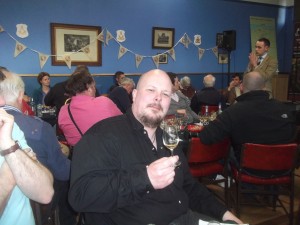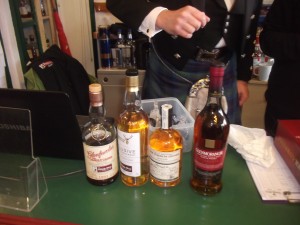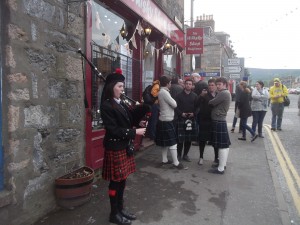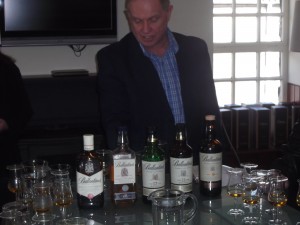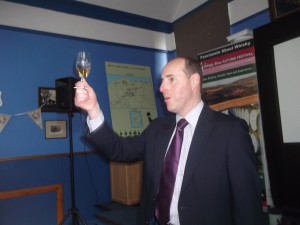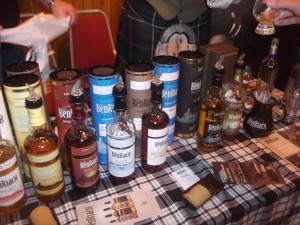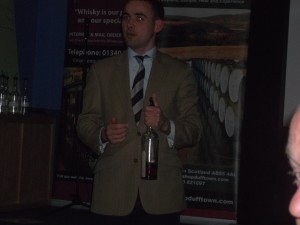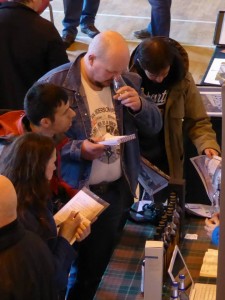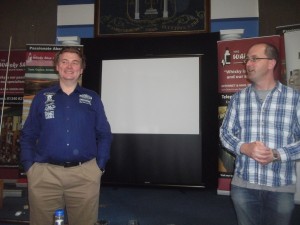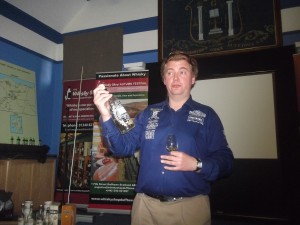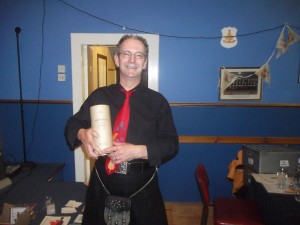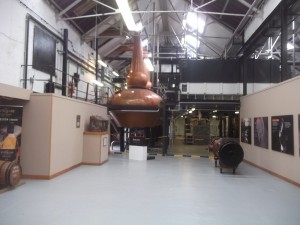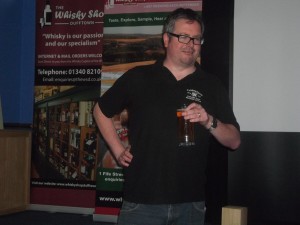This entry was posted in Whisky Tastings and Events News on .
Report by Bruce Crichton
After reading ‘Wallabies in Kangaroo Courts’ by Anubis Mulligan, I headed to Dufftown. Now well versed in marsupial legalities, the Spirit of Speyside Whisky festival was just what I needed and after many days of great whisky, food, music, tours, dress code violations and
Status Quo escapades, here is my account of it.
This report is only a rough guide and may contain factual errors, for which I apologize in advance. Tasting notes are subjective and comment is added from experts present during note taking. To shorten the report, I refer the reader to previous reports and tastings if a whisky re-appears. I also assume the reader is familiar with widely available bottlings mentioned. Any cask samples, discontinued releases and fill-your-own (FYO) tasted are described briefly, as these may not be available to buy. When water added was, literally, one drop and whiskies were 40% abv, if the strength is not otherwise indicated. Finally, many references are in this report to a prominent festivalgoer known as ‘Salmon-Pink’ who had such an impact at the festival that none of those who met him will ever forget him, no matter how hard they try.
‘It all started with a big dram’ again at the Whiskyshop Dufftown
Whisky Shop Dufftown (WSD) owner Mike Lord had selected four drams that had caught his eye. Working more efficiently than last year, he had only needed to work a series of 29-hour days to find these a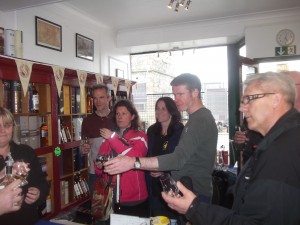 nd we began with the Chivas Cask Strength Edition 1993 Scapa, at 58.6% abv. This vintage seems to be unbeatable for the Orkney distillery as previous releases from this year by Chivas and by Gordon and MacPhail have been noted for their quality. The addition of water revealed the taste of soft bourbon and a fruity sweetness. Other whiskies from this range are available from the shop and will probably go fast.
nd we began with the Chivas Cask Strength Edition 1993 Scapa, at 58.6% abv. This vintage seems to be unbeatable for the Orkney distillery as previous releases from this year by Chivas and by Gordon and MacPhail have been noted for their quality. The addition of water revealed the taste of soft bourbon and a fruity sweetness. Other whiskies from this range are available from the shop and will probably go fast.
Next up was Glenmorangie ‘Companta’, at 46%abv. Named after the Gaelic word for friendship, this had been finished in Cote de Rhone wine casks. It had the taste of rich, dark chocolate and treacle toffees. Very heavy and rich, this tasted like a whisky that would sell well in Germany.
A 1991 Glenfarclas Family Cask, exclusive to the WSD, at 53.8%abv, was taken from a first fill Oloroso sherry butt. Mike had chosen this one from 20 samples which was, apparently, very hard work and, having chosen this one, he was heard to say ‘you’re my very, very best friend’. He also reckons that magic happens in the casks at the distillery. I found it to have the taste of thick, chewy licorice and very drying finish. Phil Yorke found the taste of lime zest. Neither of us needed to add water and one commentator found that four drops of water made the sweetness disappear to the whisky’s detriment.
Also exclusive to the shop was a 9 year old Caol Ila, at 60.3% abv, from Gordon and MacPhail. Taken from a refill bourbon cask, it had an unusually sweet nose, almost Bowmore-like with its minty notes. Phil tasted cereal and oatcakes while I got sweet and smoky flavours and a real chewiness. The finish was sweet, smoky and peppery at the very end.
Near the end, I jousted with the dapper Warren Marsden and we drew the joint conclusion that any event with a dress code would be treated by me as if it were radioactive and that I wouldn’t go to any event that had a dress code I could pass, which is especially important as I’m me and no one else is. Suddenly aware that I had begun to talk drivel at an alarmingly early stage of the evening, I decided to call it a night.
Glenburgie distillery – home of Ballantine’s
Just outside Elgin lies Glenburgie distillery, home of the Ballantine’s blends, and the first public tour for the festival was hosted by Chris Brousseau. We began with a glass of the widely available ‘Finest’ which had an interesting cereal maltiness and which this writer finds is complimented by a bag of Minstrels and either a spaghetti western or a vintage Hammer horror film.
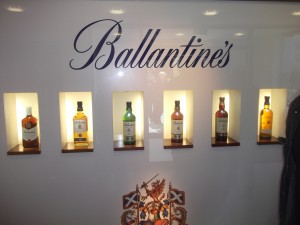
The new Glenburgie distillery was built in 2005 and the old distillery is adjacent to it, Chris told us, before giving us some factoids about the brand. Born in 1809, George Ballantine left school at 12 and opened his grocery in 1827. George was a pioneer of advertising and had innovative ideas such as free delivery, free samples and brand identity. Well ahead of his time and an expert at blending, his first releases were 5 and 7 year old whiskies. His son, George junior, continued the trend by buying whisky from Scapa in 1895, a few months after the distillery opened.
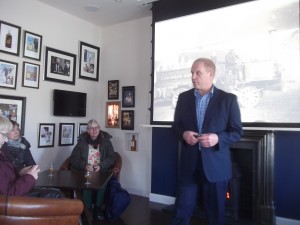
In 1810, Kilnflat distillery was founded by John Paul. In 1878, it became Glenburgie. In 1957, Hiram Walker, owners of Ballantine’s, introduced Lomond stills to make Glencraig whisky while neighbouring Miltonduff distillery made Mosstowie using the same stills. In 2008, capacity was increased to 4.2 million litres per year and the number of stills increased from 4 to 6.
There are 30 mashes per week with 7.5 tons of malt per mash. Fermentation takes 50 – 60 hours and aims to produce sweet, fruity spirit. Moving to the warehouse, Chris pointed out the unusual fact that all the casks are the same size and that all the whiskies in the blend are matured in bourbon casks. Glenburgie, together with neighbouring Miltonduff, Scapa and Glentauchers are the key Ballatine’s malts.
After re-tasting the ‘Finest’, we had the delicious 12 year old, a blend launched in 1960. The nose was soft, with syrup and honey and it tasted of spicy vanilla, warm honey and peach syrup before some light smoke on the finish. There have been 21 special releases of the blend since 1990 including 8 and 12 year old vatted or blended malts for Asia, indicating that the brand has not been content to rest on its laurels.
Ballantine’s had large stocks of old whisky, early in the 20th century, in the wake of prohibition. Because of this, they were able to launch the 17 and 30 year old blends. The 17 year old, at 43%abv, had vanilla, icing sugar and slight smoke on the nose and the same on the taste, followed by a stylish bite and a long, chewy finish. The reader is recommended to take a big mouthful and roll on the tongue for a big peat punch.
The 21 year old, also at 43%abv, had a lovely, warming character with cream, honey, smoke, and a long finish. The 30 year old had a heather honey nose. With no smoke, there was bourbon, vanilla, cream, banana foam sweets, honey and light toffee sauce. Stuart Terris got ‘Toffo’ sweets when he tasted.
We closed the session with a smooth, sweet and chewy 14 year old Glenburgie, at 60.5%abv.
Cask Strength Gordon and MacPhail
Presenting a series of cask strength whiskies from Gordon and MacPhail (G&M) was Stephen Rankin, descended from John Urquhart, the man who inherited the business from the original owners.
Bottled in January 2014, a 1995 Aberfeldy, at 55.8%abv, had been matured in refill sherry casks that gave it the smell of Refreshers and Parma violets. There was the taste of vanilla and some astringency and a peppery bite. Water revealed some citrus while Phil Yorke detected soft lemon on the palate.
As we tasted, Stephen recounted looking over archives from 1914 and finding an order for 9 pints of Linkwood. He also noted that his company has 9000 casks at distilleries, 6000 in Elgin and between 9 and 10000 at the Benromach distillery, ensuring they don’t have all their eggs in one basket, as it were.
A delicious 1991 Bruichladdich, at 54.9%abv, matured in refill hogsheads and bottled in 2012 had light, soft bourbon and floral notes. It tasted of warm, sweet vanilla and golden honey. Danny Maguire found the taste of stewed fruits on the addition of water. Danny was slightly annoyed that someone had spiked another of his drinks and, when we looked in the glass, sure enough, there were many hedgehogs swimming about merrily. Stephen finds that cask strength whiskies are generally waxy while a Dutch observer reckoned there was fudge on the taste.
2003 Benromach, at 58.2%, was in the ‘no home should be without’ category. Taken from 3 first fill bourbon casks, it smelled of toffee and fudge ice cream with toffee sauce on top. There was a pleasing smoky taste that gave way to vanilla sweetness with the addition of water.
Displaying his keen knowledge of history, Stephen told us of how John Urquhart was taken on at the age of 15 and, by 1915, owned the company. Interestingly, James Gordon’s wife thought lorries would never catch on. Praising the vision and foresight of his great grandfather, George Urquhart, Stephen said that G&M was bottling single malts some 60 years before many illustrious distilleries. He had enjoyed great relationships with distillers, helping a number of them with their cash flow and provided his own casks to mature the spirit.
Bottled in 2014, a 1995 Glentauchers, at 58.3%abv, smelled of treacle and tasted slightly prickly with toffee, cherries and a pleasant cough syrup. In fine form, Phil Yorke noted the taste of cloves and sweet oranges, with eucalyptus to finish.
Stephen found a 1994 Tormore, bottled in 2007 at 59.9%abv, very waxy. Taken from two first fill sherry casks, there were toffee, fudge, chocolate and honey aromas with the taste of stewed fruits, prunes and plums, wedding cake and icing. The finish was short but punchy, nonetheless.
As the tasting drew to a close, a strange odour became noticeable and the source of it turned out to be Salmon Pink who had arrived by bicycle earlier, having been bog snorkeling beforehand – he had forgotten to flush. Apologizing profusely, he promised to use stronger bleach next time.
Heading to the WSD, I had a perplexing encounter with a man who was filling in the whisky competition and who took exception to my Status Quo t-shirt. Turning the tables quickly, I drew the conclusion that his ire was due to his being in the band but being fired before they had any hits and he didn’t find it amusing that I told him I was staying in Atlantis with Lord Lucan, Shergar and Jimmy Hoffa, unlike all those who were standing behind him. I left him fully enveloped in the pyjamas of perplexity before heading back to the hall for my next tasting.
Berry Brothers and Rudd, the Reaper, Whitney and Jim Murray
In no mood to waste time and armed with several film soundtracks, Jonny MacMillan, presenting the best of Berry Brothers and Rudd (BBR) began with a slide comparing a single cask BBR bottling with a thinly disguised bottle of ‘Isle of Fettermore’ with the former being unchilfiltered and coloured and the latter anything but. (The alcoholic strength of each bottling is 46% abv, if not otherwise indicated).
A 1987 Linkwood, 25 years old, smelled of sherbet lemons with Jonny finding a peaches and cream character about it. Lemon zest and vanilla followed and the finish was short.
A 1993 Glen Keith, at 55.2%abv, was truly the stuff of legend. Smelling of fruit salad chew bars, the taste was rich and fruity with peach syrup. Water unlocked some bourbon notes and light golden honey and the finish was soothing and long. Jonny asked for the audience’s view of the whisky and used my exclamation of ‘awesome’ as an official note.
A 1982 Duttown, at 53.4%abv, had some light coffee and cocoa aromas and a soft, velvety taste before a creamy and slightly smoky finish. As he told us of the whisky, Jonny mentioned Whisky Bible writer Jim Murray and there suddenly came a burst of Whitney Houston singing ‘I will always love you’, followed by a montage of slides from Jonny’s presentation. Later, and too much acclaim, I suggested another movie soundtrack favourite ‘Don’t fear the reaper’ as an alternative tune to accompany the slides. Lightening the mood, Jonny told us the story of his foil, a man who wears a t-shirt saying ‘I like sniffing bungholes’, and his winning of a bet with an American in a local bar.
Moving on, a 1989 Cragganmore, at 54.5%abv, had been bottled in 2011 under the ‘John Milroy’ name. Only two casks per year are given this name and this one had some soft smoke and sweetness on the nose and a crisp taste with delicate vanilla. The finish was long.
As the tasting moved on, Salmon Pink was becoming increasingly boisterous, talking a load of Baldrick’s fine wine and smelling of it as well, winding the audience up no end.
On a more pleasant note, a 1988 Longmorn, had obvious vanilla aromas and a rich silky bourbon taste. We then ended with a very pale, peated 2006 Bunnahabhain, at 57.8%abv. This had minty toffee and smoke on the nose and subtly sweet smokiness on the taste. The finish was huge and short. As we considered the whisky, Jonny showed us a picture of the ‘Bunna Haven’ Indian restaurant, a clip of ‘The Muppets’ and slides of his bunghole-sniffing foil while recounting the tale of a car crash at the only roundabout on Islay.
Saturday Morning Whisky Fair
Apologizing for his conduct the previous day, Salmon Pink had sobered up with some of Baldrick’s coffee. This is a favourite of his as he has an inexhaustible supply of sugar substitute, judging by his clothing.
The air cleared, as far as it can with Salmon Pink around, and I was free to enjoy the fair, beginning with a 22 year old Bruichladdich, at 53.5%abv, from ‘Dreamdrams.co.uk’ was sweet and lightly salty. This old school ‘Laddie’ had a light coating of peat that gave it a spine and made it a great start to the morning.
Further highlights included G&M’s ‘MacPhail’s Collection’ 8 year old Tamdhu, at 43%abv, a cheery low-budget dram with mints and honeycomb sweets on the nose and a vanilla taste. Creamy and with a hint of smoke, a charming. 1997 Connoisseur’s Choice Jura, at 46%, had come from sherry hogsheads.
The Adelphi 1990 Benriach and Fascadale 12 year old would reappear later that day. A 1989 Bunnahabhain, at 47.2%abv, had a soft, minty nose and tasted of smoked fish. The medium length finish was salty.
Tomintoul Whisky Castle’s 1998 Glengoyne, at 53.1%abv, was fantastically dark. It had a rich nose and taste with Christmas cake and treacle flavou rs. The finish was sharp and had an extremely big punch which the reader is invited to compare to that of the standard cask strength distillery release.
As master distiller Robert Fleming told us a cautionary tale about the practice of ‘dramming’, I found the Glencadam 14 year old Oloroso finish to taste of Turkish delight. The 12 year old Port Wood finish was light with fruity and sherbet notes. Both were bottled at 46% abv.
Benriach’s new Glenglassaugh ‘Torfa’, at 50%abv, had been matured for four years in first fill bourbon casks and used barley peated to 20 parts per million (ppm). There was sweet peat on the nose while the taste was also sweet and elegant with only the finish betraying its relative youth.
Returning to the ‘Dream Drams’ table, a 10 year old Bowmore, at 60.3%abv, had been matured in a bourbon cask and offered a no-nonsense peat punch ideal for lovers of such whiskies.
Adelphi Tasting with Antonia Bruce
Hot off the bottling line or hot off Antonia’s car, were the latest Adelphi selections. Adelphi’s Ardnamurchan distillery is up but was not running, at the time of writing. The company is hopeful that distilling will begin in the late summer.
Glen Grant 21 year old, at 56.6&abv, displayed moderate beading when shaken and tasted sharp with fresh lemon while Bill Sharp found bananas and tropical fruit. A drop of water revealed pear drop sweets on the finish. A Benriach 23 year old, at 52.9%abv, had sweetness and smokiness, like many other festival drams. Antonia found Angel Delight flavours and thinks water brings out a herbal quality to the whisky.
A 32 year old Miltonduff, at 53.1%abv, had been matured in a refill bourbon cask. Antonia got baked apples on the nose while I detected lemon curd and bananas. The middle was interesting, tasting as it did of blood orange chocolate – available from Green and Black – and watered unlocked a spicy finish with some more orange sweetness. A 7 year old Glenrothes, at 67.5%abv, had the classic sherry cask tastes of Bovril, coffee and treacle. Surprisingly smooth, despite the high strength, there were also notes of Dundee cake while Antonia got almonds and marsala. Water freshened it considerably but the finish was short, as is often the case with such youthful whiskies.
Continuing Adelphi’s lightly peated Fascadale series was a 12 year old Clynelish, at 46%abv. Since Clynelish is unpeated, it’s this writer’s view that the cask had previously held spirit from the long closed Brora distillery. The whisky was very pale, having been matured in well used casks, and I smelled Refreshers, Parma violets and many other fizzy sweets. Adelphi recommend this to accompany Cullen Skink or smoked salmon. The taste was sweet, delicate and crisp with hints of salt and peat that Antonia also thinks would make this a good whisky to pair with cheese.
Morrison and Mackay Whiskies with Peter Mackay
Formerly known as Carn Mor, the company will have changed its name to ‘Morrison and Mackay’ by the time the report is published. The name change reflects some 140 years of industry experience. Morrison and Mackay plan to move to the other side of the city of Perth where a new warehouse facility will allow them to mature more whisky in sherry casks.
Peter opened with the first of four ‘Strictly Limited’ releases, all at 46%abv, a 1995 Glenallachie, taken from two bourbon hogsheads. Again, there were numerous fizzy sweets on the nose, my Achilles heel when the foot’s on the other hand. After extricating myself from this anatomical nonsense, I found the taste of crisp vanilla with both lemon zest and lemon curd before spice, pepper and bourbon appeared at the finish. As is often the case with this range, it’s recommended with literally one drop of water.
Next, Peter recounted a horror story from a festival in Frankfurt where, for an hour and three quarters, no one could touch their glass, let alone taste the whisky. Noting that their whiskies are not coloured or chilfiltered, Peter thinks adding caramel to such a whisky makes it look there’s mud in the bottle.
A 1997 Arran had been bottled only a month before, again from two bourbon casks. Lightening considerably with a drop of water there was vanilla, peaches and cream with a spicy and very long finish.
A man after my own heart in one regard, Peter told us that he likes Mortlach and he likes sherry casks but not particularly both together. Proving him correct was a lovely 1998 Mortlach that had a fizzy sherbet nose with cream, velvet, biscuits and shortbread on the taste. This truly was the stuff of legend and those sitting beside me reckoned that I had fallen in love. (I was going to tell the reader that the bottle and I eloped shortly after the festival but it turned out the bottle was already married.)
Showing that his company bottle the best Ben Nevis’s, a 1997 vintage, taken from 2 sherry butts, had spice and sherry on the nose. Better to taste than nose, the taste was dominated by sticky toffee pudding with an added gallon of toffee sauce. Taking a quick poll, it was apparent that exactly half the audience enjoyed it, confirming what Peter had suspected, that it would split the room. Peter also had an unusual encounter with a fellow supporter of his football team, St Johnstone (of Perth), and this was the first time in several decades that two St Johnstone fans had been that close together.
A 1992 Celebration of the Cask (CotC) Glen Grant, at 55.7%abv, was soft and silky with sherbet sweetness and light golden honey before a long and delicate finish. Introducing the new Black Gold series, we had a 1989 Highland Park, at 54.abv. Launched the previous Tuesday, the Black Gold range is taken from very heavy dark sherry casks. Appropriately, this bottling had all the classic sherry cask flavours but had them fiftyfold. Peter had struggled to describe the taste himself, settling for a ‘Fisher and Donaldson’ fudge doughnut from Cupar or St Andrews, in the east neuk of Fife.
Tannochbrae Gala Dinner with Robin Laing
It is with sadness that I report the untimely passing of Susie from the Tannochbrae. She had been ill for a long time and had been laid to rest shortly before the festival. A great chef and a good friend, all of us who knew her will miss her.
However, life goes on and, on Saturday night, Thomas Ewers of Malts of Scotland presented whiskies with each course while music came from the ever popular Robin Laing. Malts of Scotland are a German company and Thomas had proved very popular during his festival debut. A 1989 ‘tea-spooned’ Dufftown malt, at 53.5%abv, was exceptionally smooth and, it turned out, we were the first people to taste it.
A magnificent 1975 Strathmill, at 42.1%abv, had rich full vanilla and warm butter and, as we tasted it, Robin sang ‘Islands’ from one of his non-whisky albums and ‘Pussy in Dundee’, the story of a neutered cat. A 2001 Ledaig, at 58.9%abv, had a peat punch worthy of a classic Islay malt and softened with water. The company had begun as a hobby for Thomas, who hadn’t tasted malt whisky until he was 42.
A 1991 Benriach, at 51.6%abv, was tasted while Robin sang his ‘Speyside Whisky Song’ and I found warm, soft butter on crusty bread with some lemon notes. A 1995 Bowmore, at 53.2%abv, prompted Robin to sing ‘Reaching home’. This had been taken from a first fill oloroso cask and was like Glenfarclas 105 or Aberlour A’Bunadh with a dab of added peat. Robin followed this with an ‘Ode to peat’ and some limericks about Bowmore. He then sang and joked about Glasgow as we tasted an extremely dark 1988 Littlemill, at 52.1%, from the long gone distillery. Matured in a sherry cask, it tasted mostly of treacle.
Finally, a 2002 Bruichladdich, at 58.2%abv, had been fully matured in a red wine cask and tasted of fudge, tablet and Turkish delight. Robin sang of a ‘Turquoise frame of mind’ and a ‘Black art’.
A Sunday Morning Wheech round Speyside
Steve Oliver joined us for a bus tour with a difference. We would not tour distilleries, as such, but we would turn up and have a dram before heading to Tomintoul. We arrived at Benrinnes, one of four ‘finger print’ malts used by Johnnie Walker’s Black Label, and tasted the now hard to find Flora and Fauna 15 year old bottling. Interestingly, Steve told us that the previous release from the distillery was smoky. The 16 year old Dailuaine, from the same range, turned out to be ideal to drink in spitting rain. Exceptionally smooth, there were fudge, sherry and wedding cake notes.
Heading to Carron, we looked at the site of the new distillery on the old site of Imperial. G&M’s 1998 sherry cask matured ‘Exclusive’ bottling, at 50%abv, had the taste of syrup, toffee sauce and luxurious dark chocolate. After tasting the old Edrington bottling of Tamdhu, Steve told us he wasn’t taken with the new Ian MacLeod release which he thinks has unnecessary added colour. The last distillery we passed that morning was Tomintoul and Steve describes the 16 year old as ‘quaffing whisky’.
At the Whisky Castle, Mike Drury treated us to the 12 year old Port Wood finish that he reckons is the best from the distillery. A Strictly Limited 2000 Auchroisk was very soft and tasted of nuts and bourbon.
The castle’s own ‘Whisky Laddie’s Choice’ Mortlach, at 56.4%abv, was delicate smooth and creamy while a 1990 Connoisseur’s Choice Tamnavulin, at 43%abv, was reassuringly pale, tasting of malt and cream.
Worth noting, is the fact that Mike has some of the last available ‘Scott’s Selection’ bottles. This company was bought over, along with parent company Speyside distillers and there will be no more releases from them or from the ‘Private Cellar’ range.
Old Particular by Douglas Laing
Eager to demonstrate that his performance improves with the application of WD40, Jan Beckers returned to Dufftown to demonstrate the ‘Old Particular’ range (OP) that has filled the gap left by the popular Old Malt Cask series, now bottled by Hunter Laing. Malts from this range are bottled at 48.4%abv, up to the age of 18 and at 51.5%abv, above that age.
A 15 year old Dailuaine, smelled of buttered toast and tasted of wine, cereal and malt, with slight smoke to finish. Jan finds this one fruity.
While demonstrating his prowess with multimedia, Jan recounted tastings in Canada and Russia, where the locals need to be held back during tastings. He also told us the long story of bottling a cask from a family owned distillery near Benrinnes. They were not allowed to use the distillery name or call it ‘Green Valley Distillery’ and they subsequently were not allowed to call it ‘Ballindalloch Estate’. Eventually, they settled on naming it ‘Probably Speyside’s Finest’ and, when a member of the owning family said it was too cheap, they said that they would increase the price if permitted to use the distillery name.
A 17 year old Clynelish, taken from a refill sherry butt, had wax, honey, pineapples and tropical fruit notes. Strangely, the sherry was not apparent in the taste.
Returning to the multimedia, Jan showed us some pictures of the company’s founder, Fred Douglas Laing and demonstrated his high-tech pointer, otherwise known as his finger. A mouth-coating Craigellachie 17, from a sherry cask, was fresh and creamy with Jan getting macerated raisins while I noted orange zest on the finish, and recommended pairing it with blood orange chocolate.
A 9 year old Provenance Glenrothes, at 61.2%abv, was a sherry bomb with wedding cake, coffee, leather and other sherry notes. A spot of water opened more sweetness and some citrus notes. As we tasted, Jan talked of the gamble inherent in laying down stock for the future as it assumes the whisky will improve with age. He also said that he walks to work, very useful for tasting emergency samples.
Finally, a Director’s Cut 15 year old Laphroaig, at 53.4%abv, smelled minty and fresh, being unusually sweet. Mike Lord found licorice tastes while Jan found smoked and cured bacon. The taste was lightly phenolic and opened considerably with water.
An evening with Robin Laing
Running through his catalogue of ever-popular tunes, reviewed in previous reports, Robin told us he was working on new material and presented some of his favourite whiskies and a few newcomers. The most notable of these were the 1999 Benriach Virgin Oak finish, at 46%abv, the Glenlivet Guardian, at 48.7%abv, the Aberlour A’Bunadh batch 46, at 60.4%abv, and the Malts of Scotland Laphroaig 16 year old, at 58.2%abv. The latter tasted mostly of sherry with a dab of peat. Water revealed smoked bacon and strawberry trifle. The Guardian tasted of oranges and marmalade with burnt sugar, the A’bunadh was lighter than usual and not quite as sweet but still charming while the Benriach was spicy and soft with fizzy sherbet on the nose and distinctive bourbon notes appeared in time. Also tasted was a 1988 BBR Longmorn, reviewed earlier, that prompted Robin to tell us that he loves that distillery’s whisky at more than 20 years old and a 2002 Malts of Scotland Bruichladdich, at 55.2%abv, that was distinctly creamy.
As usual, highlights from Robin’s performance are available on both Facebook and www.youtube.com.
A Taste of Tomatin
Tomatin distillery, on the edge of Speyside, was once the largest malt whisky distillery in Scotland. Established in 1897, by the 1970’s, it was producing 12.5 million litres a year, most of which went for blending. Production, however, was scaled back in the 1980’s. Scott Fraser was our guide for the morning and he told us that water comes from the granite mountains behind the distillery and that barley is supplied by maltsters from Berwick, Inverness, Arbroath and Buckie. All but 10 days production out of the entire year uses unpeated malt though, 8 years ago, some peated spirit was produced for blending and, indeed, the Japanese owners of Tomatin also produce the Talisman, Big ‘T’ and Antiquary blends.
8 tons of malt are used and there are 12 stainless steel washbacks where fermentation takes between 85 and 95 hours. Where once there were 23 stills, today 12 stills make 2.5 million litres of alcohol per year. The spirit produced has notes of apples and wheat, judging by the ‘aftershave test’. Filling is done on site and the 14 warehouses can store up to 200,000 casks. Bourbon casks, sherry butts and port pipes are all used. A 14 year old port finish was recently released and Tomatin are currently experimenting with other wine casks and also virgin American oak. America is the biggest market for the company though China and Russia are growing while Britain and Germany are big markets for Tomatin as well.
The ‘Taste of Tomatin’ tour offers the chance to taste 5 whiskies and to fill your own (FYO) bottle at the end. Notes on these are brief since I was driving and took only the smallest of tastes. The non-age statement (NAS) ‘Legacy’, at 43%abv, had vanilla and nutty flavours, having been matured in first fill bourbon and virgin oak. The 12 year old Tomatin was smoother than the Legacy though Scott told us he does like a bite to his whisky, preferring the younger bottling. Fresh and creamy, the 12 year old had a subtle oaky taste with some wine and cereal.
Both FYO casks may be gone by the time of publication but the 12 year old FYO bourbon cask, at 57.1%abv, was, nonetheless, delicate with the taste of light honey. The 12 year old FYO refill sherry cask, at 55.7%abv, was lightly sweet, chewy and creamy. Finally, released in 2013, the Cu Bocan, at 46%abv, was smoky and sweet and the reader is invited to compare it to Benromach and Ardmore.
Creations for Cadenhead’s by Mark Watt
Entering the hall for the tasting, Mike commented that I had shaved but didn’t bristle or split hairs as Mike is known for hiding in waterholes, waiting for unsuspecting crocodiles to come into range. As I approached the front of the hall, Mark Watt was warming up with a single pint. He had already made a good start with a double of vodka and, after his pint, another double vodka brought him to 100 milligrams.
Cadenhead’s apparently like to use a distillery’s old name and, hence, a number of releases have a hyphen followed by the word ‘Glenlivet’. However, my suggestion that the 1997 Braes of Glenlivet, at 46%abv, should also have this added to its name was still just a bit daft. I found this creamy and fresh and Mark reckoned it would make a good session whisky.
A 33 year old Girvan grain whisky, at 46%abv, smelled and tasted of soft bourbon while Danny Maguire found coconuts at the finish. Mark found that, at cask strength, it had too much attack on the palate and said that Cadenhead’s assess each cask individually to decide bottling strength. Digressing slightly, he pondered the relative meaning of ‘limited edition’ releases. This bottling, for example, was from a single cask but Mark has seen ‘limited to 279 casks’ on one distillery bottling.
An excellent 23 year old Aberlour-Glenlivet, at 54.9%abv, had been taken from 2 hogsheads. With citrus and vanilla notes present, the buyer of this is recommended to roll their dram on the tongue for best results. As we considered this whisky, a Dutch whisky expert recounted a Cadenhead’s shop that doesn’t seem to sell whisky, no matter how hard he had tried to buy a bottle. Mark concurred with this, reckoning that, in some ways, he is in the field of sales prevention.
As we tasted a 24 year old Auchroisk, at 57.5%abv, Mark told us that bottles are hand-filled by the company as a bottling line is too fast and that the ‘Moidart’ vatted or blended malt is being discontinued. The Auchroisk, from a single butt, tasted of wine, cream, cereal and biscuits with a lovely bite to finish.
One pertinent observation of Mark’s is worth considering. In years gone by, word went round that some whiskies were particularly brilliant, Black Bowmore was one such release, and, once they were drunk, the surviving bottles became collectable. Now, very few collector’s item bottles are drunk with the majority being, in effect, very expensive ornaments. On a lighter note, Mark has been unable to buy Japanese whiskies for Cadenhead’s, prompting one reporter writer to ask if he wasn’t going to the wrong bars.
Fittingly, given my earlier distillery tour, we had a 1978 Tomatin, at 44.1%abv. The nose was enchanting and I could have spent all day smelling the variety of fizzy chew bar aromas present. After the fizzy nose, the taste was juicy and sweet while Mark found the finish woody but not overly so.
Ending the session was a 13 year old Bowmore, at 46%abv, from 2 casks. This was easygoing, sweet and minty while a Danish whisky buff found smoky crème brulee.
After the last tasting ended, Salmon Pink attempted to make amends for his behavior that weekend, telling me that he had once been surrounded by Komodo Dragons but escaped when they refused to eat him. However, he was humiliated when one of them told him that his breath stank. This was too much for him to bear having already been mauled by tadpoles while cycling across the Sahara desert the week before. He told me he planned to get his life together as he now had enough sob stories to be guaranteed winner of the next series of X factor and, with that, he got on his bike and departed. Sadly, these plans will never come to fruition as he was accidentally decapitated that evening while playing Sudoku.
At the WSD drams party, Mike announced that Provenance 5 year old cask strength Aultmore had won the Speyside challenge ahead of a 1987 Adelphi Mortlach while Wemyss 12 year old Spice King had won the ‘Rest of Whisky’ challenge. Interesting tasting notes included ‘Finish: not as long as my first marriage’, ‘Finish: like meeting second wife’ and ‘Like Hamburg but in a good way’. The best whisky to accompany haggis is Aberlour 15 year old ‘Select’ while bacon goes best with Benriach 20 year old.
With that, I’d like to thank everyone involved in organizing and running the festival and, in particular, Mike Lord and his wife Val, Vicky and Kirsten at the Whisky Shop, to Claus and Claire for the proofreading, to Steve Oliver, Mike Drury and everyone involved in organizing the festival.
In the late summer, I shall become an earl and receive an OBE so I hope to see you all again at the autumn festival which will be my first festival as an earlobe.

